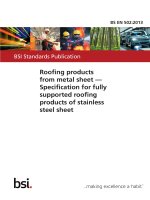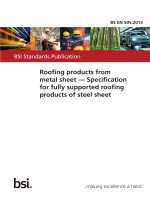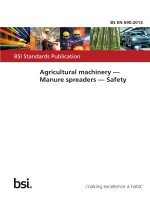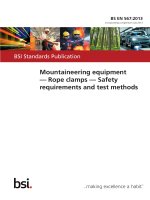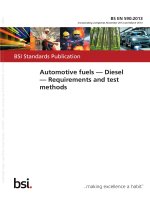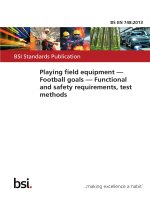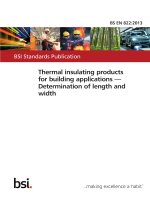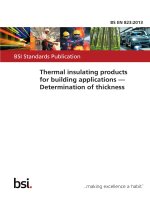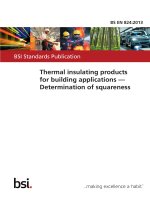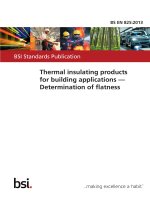Bsi bs en 62364 2013
Bạn đang xem bản rút gọn của tài liệu. Xem và tải ngay bản đầy đủ của tài liệu tại đây (3.37 MB, 76 trang )
BS EN 62364:2013
BSI Standards Publication
Hydraulic machines — Guide for
dealing with hydro-abrasive
erosion in Kaplan, Francis, and
Pelton turbines
BRITISH STANDARD
BS EN 62364:2013
National foreword
This British Standard is the UK implementation of EN 62364:2013. It is
identical to IEC 62364:2013.
The UK participation in its preparation was entrusted to Technical
Committee MCE/15, Hydraulic turbines.
A list of organizations represented on this committee can be obtained on
request to its secretary.
This publication does not purport to include all the necessary provisions of
a contract. Users are responsible for its correct application.
© The British Standards Institution 2013.
Published by BSI Standards Limited 2013
ISBN 978 0 580 66842 5
ICS 23.100.10; 27.140
Compliance with a British Standard cannot confer immunity from
legal obligations.
This British Standard was published under the authority of the
Standards Policy and Strategy Committee on 30 September 2013.
Amendments/corrigenda issued since publication
Date
Text affected
BS EN 62364:2013
EN 62364
EUROPEAN STANDARD
NORME EUROPÉENNE
EUROPÄISCHE NORM
August 2013
ICS 23.100.10; 27.140
English version
Hydraulic machines Guide for dealing with hydro-abrasive erosion in Kaplan,
Francis, and Pelton turbines
(IEC 62364:2013)
Machines hydrauliques Guide relatif au traitement de l'érosion
hydro-abrasive des turbines Kaplan,
Francis et Pelton
(CEI 62364:2013)
Wasserturbinen Leitfaden für den Umgang mit
hydroabrasiver Erosion in Kaplan-,
Francis- und Pelton-Turbinen
(IEC 62364:2013)
This European Standard was approved by CENELEC on 2013-08-01. CENELEC members are bound to comply
with the CEN/CENELEC Internal Regulations which stipulate the conditions for giving this European Standard
the status of a national standard without any alteration.
Up-to-date lists and bibliographical references concerning such national standards may be obtained on
application to the CEN-CENELEC Management Centre or to any CENELEC member.
This European Standard exists in three official versions (English, French, German). A version in any other
language made by translation under the responsibility of a CENELEC member into its own language and notified
to the CEN-CENELEC Management Centre has the same status as the official versions.
CENELEC members are the national electrotechnical committees of Austria, Belgium, Bulgaria, Croatia, Cyprus,
the Czech Republic, Denmark, Estonia, Finland, Former Yugoslav Republic of Macedonia, France, Germany,
Greece, Hungary, Iceland, Ireland, Italy, Latvia, Lithuania, Luxembourg, Malta, the Netherlands, Norway, Poland,
Portugal, Romania, Slovakia, Slovenia, Spain, Sweden, Switzerland, Turkey and the United Kingdom.
CENELEC
European Committee for Electrotechnical Standardization
Comité Européen de Normalisation Electrotechnique
Europäisches Komitee für Elektrotechnische Normung
CEN-CENELEC Management Centre: Avenue Marnix 17, B - 1000 Brussels
© 2013 CENELEC -
All rights of exploitation in any form and by any means reserved worldwide for CENELEC members.
Ref. No. EN 62364:2013 E
BS EN 62364:2013
EN 62364:2013
-2-
Foreword
The text of document 4/279/FDIS, future edition 1 of IEC 62364, prepared by IEC TC 4 "Hydraulic
turbines" was submitted to the IEC-CENELEC parallel vote and approved by CENELEC as
EN 62364:2013.
The following dates are fixed:
–
latest date by which the document has to be implemented at
national level by publication of an identical national
standard or by endorsement
(dop)
2014-05-01
–
latest date by which the national standards conflicting with
the document have to be withdrawn
(dow)
2016-08-01
Attention is drawn to the possibility that some of the elements of this document may be the subject of
patent rights. CENELEC [and/or CEN] shall not be held responsible for identifying any or all such
patent rights.
Endorsement notice
The text of the International Standard IEC 62364:2013 was approved by CENELEC as a European
Standard without any modification.
In the official version, for Bibliography, the following note has to be added for the standard indicated :
IEC 60193:1999
NOTE
Harmonised as EN 60193:1999 (not modified).
–2–
BS EN 62364:2013
62364 © IEC:2013
CONTENTS
INTRODUCTION ..................................................................................................................... 7
1
Scope ............................................................................................................................... 8
2
Terms, definitions and symbols ........................................................................................ 8
3
2.1 Units ....................................................................................................................... 8
2.2 Terms, definitions and symbols ............................................................................... 9
Abrasion rate .................................................................................................................. 11
4
3.1 Theoretical model .................................................................................................. 11
3.2 Introduction to the PL variable ............................................................................... 13
3.3 Survey results ....................................................................................................... 15
3.4 Reference model ................................................................................................... 16
Design ............................................................................................................................ 17
4.1
4.2
4.3
5
General ................................................................................................................. 17
Water conveyance system ..................................................................................... 17
Valve ..................................................................................................................... 18
4.3.1 General ..................................................................................................... 18
4.3.2 Selection of abrasion resistant materials and coating ................................ 18
4.3.3 Stainless steel overlays ............................................................................. 19
4.3.4 Protection (closing) of the gap between housing and trunnion ................... 19
4.3.5 Stops located outside the valve ................................................................. 19
4.3.6 Proper capacity of inlet valve operator ....................................................... 19
4.3.7 Increase bypass size to allow higher guide vane leakage .......................... 19
4.3.8 Bypass system design ............................................................................... 20
4.4 Turbine .................................................................................................................. 20
4.4.1 General ..................................................................................................... 20
4.4.2 Hydraulic design ........................................................................................ 20
4.4.3 Mechanical design ..................................................................................... 22
4.4.4 Operation .................................................................................................. 28
4.4.5 Spares and regular inspections ................................................................. 29
4.4.6 Particle sampling and monitoring ............................................................... 29
Abrasion resistant materials ........................................................................................... 30
5.1
6
Guidelines concerning relative abrasion resistance of materials including
abrasion resistant coatings .................................................................................... 30
5.1.1 General ..................................................................................................... 30
5.1.2 Discussion and conclusions ....................................................................... 31
5.2 Guidelines concerning maintainability of abrasion resistant coating materials ........ 32
5.2.1 Definition of terms used in this sublcause .................................................. 32
5.2.2 Time between overhaul for protective coatings .......................................... 32
5.2.3 Maintenance of protective coatings ............................................................ 33
Guidelines on insertions into specifications .................................................................... 34
6.1
6.2
6.3
6.4
Annex A
General ................................................................................................................. 34
Properties of particles going through the turbine.................................................... 35
Size distribution of particles .................................................................................. 35
Mineral composition of particles for each of the above mentioned periods ............. 36
(informative) PL calculation example ...................................................................... 37
Annex B (informative) Measuring and recording abrasion damages ..................................... 39
BS EN 62364:2013
62364 © IEC:2013
–3–
Annex C (informative) Water sampling procedure ................................................................ 52
Annex D (informative) Procedures for analysis of particle concentration, size,
hardness and shape ............................................................................................................. 53
Annex E (informative) Tests of abrasion resistant materials ................................................. 56
Annex F (informative) Typical criteria to determine overhaul time due to abrasion
erosion ................................................................................................................................. 67
Annex G (informative) Example to calculate the amount of erosion in the full model ............ 68
Annex H (informative) Examples to calculate the TBO in the reference model ...................... 70
Bibliography .......................................................................................................................... 73
Figure 1 – Estimation of the characteristic velocities in guide vanes, W gv , and runner,
W run , as a function of turbine specific speed ........................................................................ 13
Figure 2 – Example of flow pattern in a Pelton injector at different load ................................ 14
Figure 3 – Example of protection of transition area ............................................................... 19
Figure 4 – Runner blade overhang in refurbishment project .................................................. 21
Figure 5 – Example of “mouse-ear” cavitation on runner band .............................................. 22
Figure 6 – Detailed design of guide vane trunnion seals ....................................................... 23
Figure 7 – Example of fixing of facing plates from the dry side .............................................. 25
Figure 8 – Head cover balancing pipes with bends ................................................................ 26
Figure 9 – Step labyrinth with optimized shape for hard coating ............................................ 28
Figure 10 – Development of spiral pressure over time ........................................................... 33
Figure D.1 – Typical examples of particle geometry .............................................................. 55
Figure E.1 – Schematic of test rig used for test 1 .................................................................. 56
Figure E.2 – ASTM test apparatus ........................................................................................ 58
Figure E.3 – Test coupon ...................................................................................................... 59
Figure E.4 – Slurry pot test facility ........................................................................................ 60
Figure E.5 – High velocity test rig ......................................................................................... 61
Figure E.6 – Samples are located on the rotating disk .......................................................... 62
Figure E.7 – Comparison of two samples after testing ........................................................... 62
Figure E.8 – Whole test system of rotating disk .................................................................... 62
Figure E.9 – Schematic of test rig used for test 8 .................................................................. 64
Figure E.10 – Testing of samples on hydro abrasive stand ................................................... 65
Figure E.11 – Cover of disc .................................................................................................. 65
Figure E.12 – Curve of unit abrasion rate with circumference velocity for 3 kinds of
materials ............................................................................................................................... 66
Table 1 – Data analysis of the supplied questionnaire ........................................................... 16
Table 2 – Overview over the feasibility for repair C ............................................................... 33
Table 3 – Form for properties of particles going through the turbine ...................................... 35
Table 4 – Form for size distribution of particles ..................................................................... 36
Table 5 – Form for mineral composition of particles for each of the above mentioned
periods ................................................................................................................................. 36
Table A.1 – Example of documenting sample tests ............................................................... 37
Table A.2 – Example of documenting sample results ............................................................ 38
Table B.1 – Inspection record, runner blade inlet form .......................................................... 44
–4–
BS EN 62364:2013
62364 © IEC:2013
Table B.2 – Inspection record, runner blade outlet form ........................................................ 45
Table B.3 – Inspection record, runner band form................................................................... 46
Table B.4 – Inspection record, guide vanes form................................................................... 47
Table B.5 – Inspection record, facing plates and covers form ................................................ 48
Table B.6 – Inspection record, upper stationary seal form ..................................................... 49
Table B.7 – Inspection record, upper rotating seal form ........................................................ 49
Table B.8 – Inspection record, lower stationary seal form ..................................................... 50
Table B.9 – Inspection record, lower rotating seal form ......................................................... 51
Table E.1 – Relative wear resistance in laboratory test 1 ...................................................... 57
Table E.2 – Relative wear resistance in laboratory test 2 ...................................................... 57
Table E.3 – Relative wear resistance in laboratory test 3 ...................................................... 58
Table E.4 – Relative wear resistance in test 4 ....................................................................... 59
Table E.5 – Results of test .................................................................................................... 60
Table E.6 – Results of test .................................................................................................... 61
Table E.7 – Results from test ................................................................................................ 63
Table E.8 – Relative wear resistance in laboratory test 8 ...................................................... 64
Table E.9 – Results of relative wear resistance for some materials (U = 40m/s) .................... 66
Table G.1 – Calculations ....................................................................................................... 69
Table H.1 – Pelton turbine calculation example ..................................................................... 70
Table H.2 – Francis turbine calculation example ................................................................... 71
BS EN 62364:2013
62364 © IEC:2013
–7–
INTRODUCTION
Many owners of hydroelectric plants contend with the sometimes very aggressive
deterioration of their machines due to particle abrasion. Such owners must find the means to
communicate to potential suppliers of machines for their sites, their desire to have the
particular attention of the designers at the turbine design phase, directed to the minimization
of the severity and effects of particle abrasion.
Limited consensus and very little quantitative data exists on the steps which the designer
could and should take to extend the useful life before major overhaul of the turbine
components when they are operated under severe particle abrasion service. This has led
some owners to write into their specifications, conditions which cannot be met with known
methods and materials.
–8–
BS EN 62364:2013
62364 © IEC:2013
HYDRAULIC MACHINES –
GUIDE FOR DEALING WITH HYDRO-ABRASIVE EROSION
IN KAPLAN, FRANCIS, AND PELTON TURBINES
1
Scope
This Guide serves to:
a) present data on particle abrasion rates on several combinations of water quality, operating
conditions, component materials, and component properties collected from a variety of
hydro sites;
b) develop guidelines for the methods of minimizing particle abrasion by modifications to
hydraulic design for clean water. These guidelines do not include details such as hydraulic
profile shapes which should be determined by the hydraulic design experts for a given
site;
c) develop guidelines based on “experience data” concerning the relative resistance of
materials faced with particle abrasion problems;
d) develop guidelines concerning the maintainability of abrasion resistant materials and hard
facing coatings;
e) develop guidelines on a recommended approach, which owners could and should take to
ensure that specifications communicate the need for particular attention to this aspect of
hydraulic design at their sites without establishing criteria which cannot be satisfied
because the means are beyond the control of the manufacturers;
f)
develop guidelines concerning operation mode of the hydro turbines in water with particle
materials to increase the operation life;
It is assumed in this Guide that the water is not chemically aggressive. Since chemical
aggressiveness is dependent upon so many possible chemical compositions, and the
materials of the machine, it is beyond the scope of this Guide to address these issues.
It is assumed in this Guide that cavitation is not present in the turbine. Cavitation and
abrasion may reinforce each other so that the resulting erosion is larger than the sum of
cavitation erosion plus abrasion erosion. The quantitative relationship of the resulting
abrasion is not known and it is beyond the scope of this guide to assess it, except to
recommend that special efforts be made in the turbine design phase to minimize cavitation.
Large solids (e.g. stones, wood, ice, metal objects, etc.) traveling with the water may impact
turbine components and produce damage. This damage may in turn increase the flow
turbulence thereby accelerating wear by both cavitation and abrasion. Abrasion resistant
coatings can also be damaged locally by impact of large solids. It is beyond the scope of this
Guide to address these issues.
This guide focuses mainly on hydroelectric powerplant equipment. Certain portions may also
be applicable to other hydraulic machines.
2
2.1
Terms, definitions and symbols
Units
The International System of Units (S.I.) is adopted throughout this guide but other systems
are allowed.
BS EN 62364:2013
62364 © IEC:2013
2.2
–9–
Terms, definitions and symbols
For the purposes of this document, the following terms, definitions and symbols apply.
NOTE
They are also based, where relevant, on IEC/TR 61364.
Subclause
2.2.1
2.2.2
Term
Definition
Symbol
Unit
specific
hydraulic
energy of a
machine
specific energy of water available between the high and
low pressure reference sections 1 and 2 of the machine
E
J/kg
acceleration
due to gravity
local value of gravitational acceleration at the place of
testing
g
m/s 2
H
m
D
m
Note 1 to entry:
Note 1 to entry:
2.2.3
turbine head
For full information, see IEC 60193.
For full information, see IEC 60193.
available head at hydraulic machine terminal
H = E/g
pump head
2.2.4
reference
diameter
reference diameter of the hydraulic machine
Note 1 to entry: For Pelton turbines this is the pitch
diameter, for Kaplan turbines this is the runner chamber
diameter and for Francis and Francis type pump turbines
this is the blade low pressure section diameter at the
band
Note 2 to entry:
See IEC 60193 for further information.
2.2.5
abrasion depth
depth of metal layer that has been removed from a
component due to particle abrasion
S
mm
2.2.6
characteristic
velocity
characteristic velocity defined for each machine
component and used to quantify particle abrasion
damage
W
m/s
C
kg/m 3
PL
kg × h/m 3
Note 1 to entry:
2.2.7
2.2.8
See also 2.2.20 to 2.2.24.
particle
concentration
the mass of all solid particles per m 3 of water solution
particle load
the particle concentration integrated over the time, T, that
is under consideration
Note 1 to entry: In case the particle concentration is
expressed in ppm it is recommended to use the mass of
particles per mass of water, so that 1 000 ppm
approximately corresponds to 1 kg/m 3 .
T
∫
PL = C( t ) × K size ( t ) × K shape ( t ) × K hardness ( t )dt
0
N
≈
Cn × K size,n × K shape ,n × K hardness ,n × Ts ,n
n =1
∑
C(t) = 0 if no water is flowing through the turbine.
If the unit is at standstill with pressurized spiral case then
C(t)=0 when calculating PL for runner and labyrinth seals,
but C(t)≠0 when calculating PL for guide vanes and facing
plates.
2.2.9
size factor
factor that characterizes how the abrasion relates to the
size of the abrasive particles
K size
2.2.10
shape factor
factor that characterizes how the abrasion relates to the
shape of the abrasive particles
K shape
2.2.11
hardness factor
factor that characterizes how the abrasion relates to the
hardness of the abrasive particles
K hardness
– 10 –
Subclause
Term
Definition
BS EN 62364:2013
62364 © IEC:2013
Symbol
Unit
2.2.12
material factor
factor that characterizes how the abrasion relates to the
material properties of the base material
Km
2.2.13
flow coefficient
coefficient that characterizes how the abrasion relates to
the water flow around each component
Kf
mm × s 3,4
kg × h × m α
2.2.14
sampling
interval
the time interval between two water samples taken to
determine the concentration of abrasive particles in the
water
Ts
h
2.2.15
yearly particle
load
the total PL for 1 year of operation, i.e. PL for T = 8 760 h
calculated in accordance with 2.2.8
PL year
kg × h/m 3
2.2.16
maximum
concentration
the maximum concentration of abrasive particles over a
specified time interval
C max
kg/m 3
2.2.17
particle median
diameter
the median diameter of abrasive particles in a sample,
i.e. such diameter that the particles with size smaller than
the value under consideration represent 50 % of the total
mass of particles in the sample
dP 50
mm
2.2.18
wear
resistance
index
abrasion depth or volume of a reference material
(generally some version stainless steel) divided by the
abrasion depth or volume of the material in question,
tested under the same conditions
WRI
-
2.2.19
impingement
angle
the angle between the particle trajectory and the surface
of the substrate
2.2.20
characteristic
velocity in
Francis guide
vanes
flow through unit divided by the minimum flow area at the
guide vane apparatus estimated at best efficiency point
characteristic
velocity in
Kaplan guide
vanes
2.2.21
2.2.22
2.2.23
Q
Wgv =
a × Z 0 × B0
characteristic
velocity in
guide vanes of
Kaplan,
Francis or
tubular
turbines
speed of the water flow at guide vane location
characteristic
velocity in
Pelton injector
speed of the water flow at injector location
characteristic
velocity in
Kaplan or
Francis tubular
turbine runner
the relative velocity between the water and the runner
blade estimated with below formulas at best efficiency
point
Wgv = 0,5 × 2 × E
Winj =
2× E
o
W gv
m/s
W gv
m/s
W inj
m/s
W run
m/s
W run
m/s
Wrun = u2 2 + c2 2
u2 = n × π × D
c2 =
Q×4
π × D2
Note 1 to entry: In calculation of c 2 for Kaplan turbines,
the hub diameter has been neglected in the interest of
simplicity.
characteristic
velocity in
Pelton runner
speed of the water flow at a Pelton runner
2.2.25
discharge
(volume flow
rate)
volume of water per unit time passing through any section
in the system
Q
m 3 /s
2.2.26
guide vane
opening
average shortest distance between adjacent guide vanes
(at a specified section if necessary)
A
m
2.2.24
Wrun = 0,5 × 2 × E
BS EN 62364:2013
62364 © IEC:2013
Subclause
– 11 –
Term
Definition
Note 1 to entry:
Symbol
Unit
For further information, see IEC 60193.
2.2.27
number of
guide vanes
total number of guide vanes in a turbine
z0
2.2.28
distributor
height
height of the distributor in a turbine
B0
m
2.2.29
rotational
speed
number of revolutions per unit time
n
1/s
2.2.30
specific speed
commonly used specific speed to of an hydraulic machine
ns
ns =
60 × n × P
H5/ 4
P and H are taken in the rated operating point and given
in kW and m respectively
2.2.31
output
output of the turbine in the rated operating point
2.2.32
actual abrasion
depth of target
unit
the estimated depth of metal that will be removed from a
component of the target turbine due to particle abrasion
actual abrasion
depth of
reference unit
the actual depth of metal that has been removed from a
component of the reference turbine due to particle
abrasion
2.2.33
Note 1 to entry:
Note 1 to entry:
P
kW
S target,
mm
S ref,
mm
actual
For use with the Reference model.
actual
For use with the Reference model.
2.2.34
number of
nozzles
number of nozzles in a Pelton turbine
z0
2.2.35
bucket width
bucket width in a Pelton runner
B2
2.2.36
number of
buckets
number of buckets in a Pelton runner
z2
2.2.37
time between
overhaul for
target unit
time between overhaul for target unit
TBO target
h
time between
overhaul for
reference unit
time between overhaul for reference unit
TBO ref
h
turbine
reference size
the reference size for calculation curvature dependent
effects of erosion
RS
m
2.2.38
2.2.39
Note 1 to entry:
Note 1 to entry:
mm
For use with the reference model.
For use with the reference model.
Note 1 to entry: For Francis turbines, it is the reference
diameter, D (see 2.2.4).
Note 2 to entry:
width, B.
For Pelton turbines it is the inner bucket
Note 3 to entry: For further information in the inner
bucket width, B, see IEC 60609-2.
2.2.40
size exponent
exponent that describes the size dependant effects of
erosion in evaluating RS
p
2.2.41
exponent
numerical value of 0,4-p that balances units for K f
α
3
3.1
Abrasion rate
Theoretical model
In order to demonstrate how different critical aspects impact the particle abrasion rate in the
turbine, the following formula is considered:
– 12 –
BS EN 62364:2013
62364 © IEC:2013
dS/dt = f(particle velocity, particle concentration, particle physical properties, flow pattern,
turbine material properties, other factors)
However, this formula being of little practical use, several simplifications are introduced. The
first simplification is to consider the several variables as independent as follows:
dS/dt = f(particle velocity) × f(particle concentration) × f(particle physical properties, turbine
material properties) × f(particle physical properties) × f(flow pattern) × f(turbine material
properties) × f(other factors)
This simplification is not proven. In fact, many examples can be found where this
simplification was not strictly valid. Nevertheless, based on literature studies and experience,
this simplification is considered to be justified for hydraulic machines.
The next simplification consists in assigning values to the functions. In the following equations
the numerical values for the parameters, without units, have to be used. The units in which
the values should be based are given below:
•
f(particle velocity) = (particle velocity) n . In the literature abrasion is often considered
proportional to the velocity raised to an exponent, n. Most references give values of n
between 2 and 4. In this guide we suggest to use n = 3,4. Particle velocity in m/s,
•
f(particle concentration) = particle concentration in kg/m 3 ,
•
f(particle physical properties, turbine material properties) = K hardness = function of how
hard the particles are in relation to the material at the surface. At the present stage we
suggest to use K hardness = fraction of particles harder than the material at the surface,
•
f(flow pattern) = K f /RS p (K f = constant for each turbine component, RS = turbine
reference size in m, p = exponent for each turbine component). K f considers
impingement angle and flow turbulence. RS p considers part curvature radius,
•
f(particle physical properties) = f(particle size, particle shape, particle hardness) =
f(particle size) × f(particle shape) = K size × K shape . Note that in this simplification it as
assumed that there is no influence from the particle hardness for this function. The
particle hardness is considered in the K hardness factor,
•
K size = median diameter of particles in mm,
•
K shape = f(particle angularity). It is believed that K shape will increase with the degree of
irregularity of the particles. Specific data is not available at present but several
literature references indicate that K shape varies from 1 to 2 from round to sharp,
•
f(turbine material properties) = K m . In this guide we consider K m = 1 for martensitic
stainless steel with 13 % Cr and 4 % Ni and K m = 2 for carbon steel. For coated
components K m should be smaller than 1,
•
f(other factors) = 1.
Again, these functions are engineering approximations in order to obtain useful results for
hydraulic machines. We then have the following formula
dS/dt = (particle velocity) 3,4 × C × K hardness × K size × K shape × K f /RS p × K m
The final step is to integrate this formula with respect to time. When we do this we find three
distinct different types of variables with respect to their variations in time:
1) particle velocity and K f : these variables vary with the water flow relative to the
individual component, which in turn may vary with the head and flow;
2) C, K hardness , K size and K shape : these variables vary with the particle properties.
Integrated over time these variables become particle load, PL (see 2.2.8 for definition
of PL and Annex A for a sample calculation);
3) RS, p and K m : these variables are constant in time.
BS EN 62364:2013
62364 © IEC:2013
– 13 –
To find a simple and reasonably accurate estimate of the time integral, the PL variable (see
2.2.8) is introduced. PL integrates C, K hardness , K size and K shape over time. When using PL,
the particle velocity and K f can be considered approximately constant over a limited variation
of head and flow (see 3.2). Since these variables are considered constant, K f and p were used
as calibration factors to obtain good agreement between actual test data and the formula. The
particle velocity can be replaced with the characteristic velocity, W, defined in 2.2.20 to
2.2.24.
W may be calculated for a specific turbine based on main data and dimensions. Since the
effect of velocity on abrasion is proportional to the velocity raised to a power of 3,4 it is very
important to estimate it accurately. For new turbines during design and bid stage, W for
different components should be provided by the turbine manufacturer. When this is not
possible, W can be estimated approximately from the diagram in Figure 1.
2.5
Characteristic velocity coefficient Wgv, Wrun
Wrun = (0,25 + 0,003 × ns) × (2 × g × H)0,5
2.0
1.5
1.0
Wgv = 0,55 × (2 × g × H)0,5
0.5
0.0
0
100
200
300
400
500
600
700
800
Turbine specific speed (using m, kW)
NOTE Values of ns and H in this figure refer to the rated operating point while the characteristic velocities are
given for the points noted in 2.2.
Figure 1 – Estimation of the characteristic velocities in guide vanes, W gv , and runner,
W run , as a function of turbine specific speed
So the final, time integrated formula becomes:
S = W 3,4 × PL × K m × K f / RS p
S is the numerical value of the abrasion depth in mm.
3.2
Introduction to the PL variable
In this code the PL variable has been introduced, which has not been widely used before. One
common way to integrate abrasion over time has been to consider the total weight of particles
– 14 –
BS EN 62364:2013
62364 © IEC:2013
that pass the turbine. However, this approach has usually not considered the effects from
variation in flow or head in the turbine and could therefore lead to erroneous conclusions.
To illustrate this consider the following example. A Pelton injector (see Figure 2) operates for
one day. Assume the head is 800 m and the abrasive particle concentration is 0,1 kg/m 3 .
Case 1: At full opening (top half of Figure 2) the water with particles flows over the seat
ring with a velocity of (2×g×H) 0,5 = 125 m/s. In one day the amount of particles that pass
the injector is 2 m 3 /s × 3 600 s/h × 24 h/day × 0,1 kg/m 3 × 1 day = 17 tons.
Case 2: At 10 % opening (bottom half of Figure 2) the water with particles flows over
the seat ring with the same velocity as in case 1 (125 m/s). In one day the amount of
particles that pass the injector is 0,2 × 3 600 × 24 × 0,1 × 1 = 1,7 tons.
In both cases the seat ring has been subject to abrasion with the same particle concentration,
the same water velocity and the same amount of time. Therefore, the expected abrasion
damage is the same. The PL variable also gives the same value in both cases. However, the
total weight of particles that has passed the unit is 10 times higher in case 1 compared to
case 2. So, PL is expected to correlate better with abrasion damage than the total weight of
particles that has passed the seat ring.
3
Full opening Q = 2 m /s
3
10 % opening Q = 0,2 m /s
Figure 2 – Example of flow pattern in a Pelton injector at different load
The same type of reasoning can also be applied to other components subject to abrasion. In
the following is a condensed summary of such analysis.
•
Pelton needle tip
Very good correlation between PL and abrasion damage with minor influence of turbine
discharge or head is expected. Some influence from the turbine flow since the water velocity
is lower further inside the injector, where the needle is located at high flows. Some influence
from turbine head since the water velocity is proportional to the square root of the head. With
head and flow variations that are normal in Pelton projects this influence is disregarded in the
interest of simplicity.
•
Pelton runner
Good correlation between PL and abrasion damage with minor influence of turbine discharge
or head is expected. Some influence from the turbine flow since the water film is thicker at
higher flows and therefore more particles may be pressed towards the outside surface due to
centrifugal forces. Some influence from turbine head since the relative water velocity in the
BS EN 62364:2013
62364 © IEC:2013
– 15 –
runner depends on the head. With head and flow variations that are normal in Pelton projects,
this influence is disregarded in the interest of simplicity.
•
Francis and Kaplan guide vanes and covers / facing plates
Good correlation between PL and abrasion damage with minor influence of turbine discharge
or head is expected. Some influence from the turbine flow since the water velocity is higher at
low discharge and the pressure difference between the two sides of the guide vane varies
with flow. In particular, if the unit is at standstill with pressurized spiral case the leakage flow
through the guide vanes has high velocity. Some influence from the turbine head since the
relative water velocity in the guide vanes depends on the head. With head and flow variations
that are normal in Francis and Kaplan projects, this influence is disregarded in the interest of
simplicity.
•
Francis runner seals / labyrinths
Very good correlation between PL and abrasion damage with minor influence of turbine
discharge or head is expected. Some influence is expected from the turbine flow and head
since they influence the pressure before and after the seal and thus the leakage flow through
the seal. With head and flow variations that are normal in Francis projects, this influence is
disregarded in the interest of simplicity.
•
Francis runner blade inlet
Good correlation between PL and abrasion damage with minor influence of turbine discharge
or head is expected. Some influence from the turbine discharge is expected since the water
velocity is higher at low discharge. Moreover, the pressure difference between the two sides
of the guide vanes varies with opening, resulting in more leakage between the guide vanes
and the covers which in turn results in more unfavourable flow conditions at the runner inlet.
Also discharge and head variations from the optimum operating point, will result in more
unfavourable flow conditions at the runner inlet. With head and flow variations that are normal
in Francis projects this influence is disregarded, as long as inlet cavitation is not present, in
the interest of simplicity.
•
Francis runner blade outlet
Reasonable correlation between PL and abrasion damage with minor influence of turbine
discharge or head is expected. At part load there are two main phenomena that influence the
wear. One is that the average velocity (defined as the total flow divided by the flow passage
area) will decrease with decreasing discharge. The other is that the degree of turbulence will
increase and the flow distribution will lose uniformity at low discharge (typically below 50 % to
80 % of maximum discharge). These two phenomena influence the wear in opposite ways, but
it is expected that the turbulence effect will dominate and thus that the wear will increase at
partial load. However, due to lack of supporting data this influence is disregarded in the
interest of simplicity.
•
Kaplan runner blade
Very good correlation between PL and abrasion damage with minor influence of turbine
discharge or head is expected. With head and flow variations that are normal in Kaplan
projects this influence is disregarded in the interest of simplicity.
•
Kaplan runner chamber
Good correlation between PL and abrasion damage with minor influence of turbine discharge
or head is expected. With head and flow variations that are normal in Kaplan projects this
influence is disregarded in the interest of simplicity.
3.3
Survey results
A questionnaire was sent to plant operators at sites known for their exposure to particle
abrasion problems. The purpose of this questionnaire was to collect and analyse data on
BS EN 62364:2013
62364 © IEC:2013
– 16 –
particle abrasion rates on as many combinations of water quality, operating conditions,
component materials, and component properties as possible.
This data was analyzed and the factor K f and the exponent p determined for each component
to get the best possible correspondence between the calculated and observed amount of
erosion. The average K f was then determined for all observations with components of the
same type. Table 1 below shows the resulting K f and p for various components as well as the
number of observations. The ratio between the measured and calculated values of the
abrasion depth was determined and the standard deviation calculated.
Table 1 – Data analysis of the supplied questionnaire
Component
Exponent p
(for RS)
Kf
Number of
observations
Standard
deviation
%
Francis guide vanes
1,06 × 10 -6
0,25
7
42
Francis facing plates
0,86 × 10 -6
0,25
7
38
Francis labyrinth seals
0,38 × 10 -6
0,75
7
30
0,90 × 10
-6
0,25
6
26
0,54 × 10
-6
0,75
6
41
Francis runner inlet
Francis runner outlet
Although the values of standard deviation in the table above shows that the formula gives
reasonable accuracy, it should be kept in mind that the amount of observations is limited and
that further observations may improve the formula.
It is only for Francis turbines that enough data has been available for a meaningful analysis.
Not enough data is available for Kaplan and Pelton turbines to give detailed guidelines.
In general, it is challenging to obtain complete and unambiguous observations from existing
measurements. It is hoped that additional observations can be made in the future to further
calibrate and revise the erosion model.
3.4
Reference model
In the Reference model presented in this guide the TBO of two turbines are compared to each
other. To do this the TBO of one turbine (here called reference turbine) and the differences in
the influencing parameters to another turbine (here called target turbine) have to be known to
calculate the TBO of the target turbine. Note that the same overhaul criteria have to be
applied for both the target and reference turbines.
The aim of the Reference model is not to calculate the erosion depth (S). Therefore a
calibrated model for the depth is not necessary. The criteria for the TBO can be the relative
amount of damage, the efficiency loss or some other criteria but has to be the same for both
turbines.
There are a few differences in the way the formula is built up between the Reference model
and the absolute model as follows:
•
•
•
since the Reference model does not calculate the erosion depth of individual
components, constants valid for the whole turbine are used instead of different
constants for different components;
a larger turbine can normally withstand more abrasion depth than a small turbine
before it needs overhaul. For this reason the exponent for turbine reference size, p, is
chosen as 1 in the Reference model;
for Pelton turbines it is assumed that the critical component for overhaul is the runner.
In addition to the factors described above, the K f for Pelton runners is assumed to be
BS EN 62364:2013
62364 â IEC:2013
ã
17
proportional to the number of nozzles and the speed and inversely proportional to the
number of buckets;
for Pelton turbines the reference size is taken as the bucket width, B 2 , instead of the
runner diameter.
The TBO for the target turbine can be calculated as follows:
TBO target / TBO ref = Wref 3,4 / Wtarget 3,4 × PLref / PLtarget × Km,ref / Km,target × Kf,ref / Kf,target
× RStarget p / RSref p
In this equation we use the following values for the relationships:
Pelton turbines: Kf, ref / Kf, target = z 0,ref × n ref × z 2,target / (z 0,target × n target × z 2,ref )
Francis and Kaplan turbines: K f,ref / K f,target = 1
Size exponent: p = 1
The accuracy of the Reference model might decrease when the differences between the
reference and target turbines become large.
The sensitivity of the calculated TBO value to variances in the input variables can also be
studied with the same formula.
4
4.1
Design
General
The following guidelines explain some recommended methods to minimize particle abrasion
and the effects thereof, by modifying the design for clean water.
It should be understood that every hydraulic powerplant is a compromise between several
requirements. While it is possible to design a unit to be more resistant against particle
abrasion this may adversely affect other aspects of the turbine. Some examples are:
•
thicker runner blades may result in decreased efficiency and increased risk of vibrations
from von Karman vortices,
•
fewer runner blades (in order to improve the access to the blade surfaces for thermal
spray surface treatment) may result in reduced cavitation performance,
•
abrasion resistant coatings may initially result in increased surface roughness, which may
reduce the efficiency,
•
reduced runner blade overhang may result in reduced cavitation performance, which in
turn may reduce the output that can be achieved for a turbine upgrade,
•
many abrasion resistance design features will increase the total cost of the powerplant.
The optimum combination of abrasion resistant design features should be considered and
selected for each site based on its specific conditions.
4.2
Water conveyance system
An important consideration for the water conveyance system is to remove as many particles
as possible already before they enter the high velocity zones in the machinery. Large
reservoirs may be very useful for this purpose. If a large reservoir is not available, so-called
desilting chambers may be built. It appears that the minimum particle size that can be
removed by desilting chambers is to the order of 0,1 mm to 0,3 mm unless the cost and size
of the structures becomes prohibitive. The detailed design of desilting chambers is outside the
scope of this Guide.
– 18 –
BS EN 62364:2013
62364 © IEC:2013
It is also important that any transient conditions that the powerplant may experience do not
disturb the sand in sand traps, or other places where sand may accumulate, so that it is
drawn into the turbine. Therefore, the design of sand traps should also consider possible
transient conditions.
Even small amounts of large particles, such as stones, can cause severe damage since they
may not be able to pass the turbine until they have been crushed into smaller pieces. This is
due to the centrifugal force in the rotating water between runner and guide vanes. It is
therefore important that tunnels and penstocks are clean and tidy at initial startup and after
maintenance work.
Due to generally low velocity the water conveyance system itself seldom sees significant
abrasion damage and normal coating paint is usually enough to protect it.
4.3
4.3.1
Valve
General
If solid particle abrasion is expected, as a general rule all mechanical disturbances in the flow
are subject to high abrasive attack. Therefore a spherical valve should be preferred instead of
a butterfly valve where the sealing disc is continuously exposed to the abrasive water flow.
As a general rule for the design, the area exposed to the abrasive water should be as small
as possible. Discontinuities and sharp transitions or direction change of the flow should also
be avoided.
The shape of the housing around the sealing of the rotor or disc shall be smooth without
sharp edges and big changes in the flow direction.
In case of several units on a single penstock and with a spherical valve or a butterfly biplane
valve as inlet valve, it is preferable to have a maintenance seal in addition to the service seal.
This will make it possible to do maintenance of the downstream seal while the other units are
in service.
A ring gate is a special type of valve and similar considerations apply to the ring gate and the
main inlet valve.
4.3.2
Selection of abrasion resistant materials and coating
The selection of materials and possible abrasion resistant coatings for components which are
subject to abrasive wear is important. See also Clause 5.
Because corrosion with simultaneously acting abrasion increases the wear rate, stainless
steel is the preferred selection. Weldable stainless steel materials are preferred. On the basis
of the larger hardness, martensitic steel is favored over austenitic steel. Weldability and
erosion resistance are often contradictory and an optimum should be sought in each case.
The possibility to weld in situ is an advantage for future repair.
In case abrasion resistant coatings are not applied, it is recommended to make a mechanical
component design where such coatings can easily be applied at a later stage.
The whole sealing area should be made of stainless steel and, if subject to abrasive wear, a
coating should be applied.
BS EN 62364:2013
62364 © IEC:2013
4.3.3
– 19 –
Stainless steel overlays
Stainless steel welded overlays with sufficient thickness may be used instead of solid
stainless components, if the abrasion area is not too large.
4.3.4
Protection (closing) of the gap between housing and trunnion
The area between trunnion and housing is especially susceptible for abrasive wear. Since the
transition trunnion to the rotor is one of the highly stressed areas of the inlet valves this area
has to be especially protected. Completely stainless or welded stainless overlay protected
trunnions are recommended. Through a pre-labyrinth, the transitions can be protected against
the direct attack of abrasive particles (see Figure 3).
Figure 3 – Example of protection of transition area
4.3.5
Stops located outside the valve
In abrasive conditions, it is recommended that stops, which limit the angle of rotation of the
rotor, are placed outside of the flow in the servomotor or adjacent to the lever.
4.3.6
Proper capacity of inlet valve operator
Normally inlet valves will be opened or closed with an approximately balanced pressure that is
established by the bypass or the movable sealing rings.
If excessive abrasion occurs at the guide vanes, the differential pressure for the closing or
opening of the inlet valve may be bigger than allowed or fixed in the layout. It is therefore
recommended that the design takes into account a higher differential pressure for opening or
closing. If the inlet valve is designed as an emergency shutoff valve it may already be able to
open against a higher differential pressure.
Please see 5.2.2 for an example of how the pressurization of the spiral case can develop with
abrasive wear in the guide vanes.
4.3.7
Increase bypass size to allow higher guide vane leakage
As already mentioned in 4.3.6 above, due to the excessive abrasion at the guide vanes the
leakage water flow will increase to such an extent, that the balance water flow through the
bypass of the inlet valve is not sufficient to achieve the pressure balance between the inlet
pipe and spiral casing.
It is therefore recommended to increase the capacity of the bypass system.
